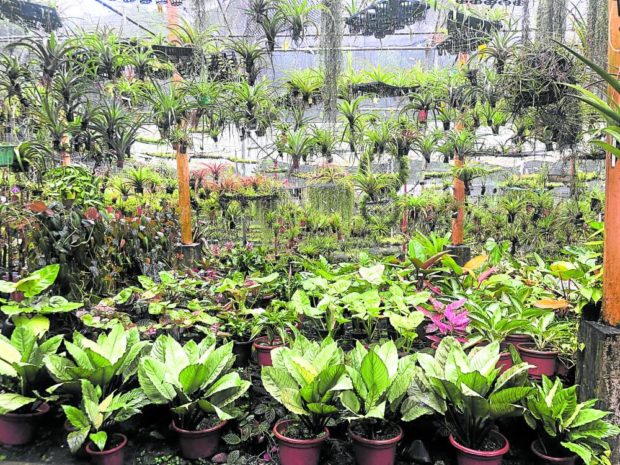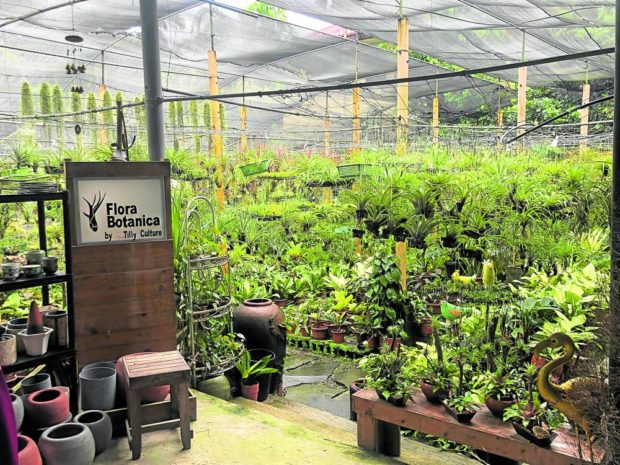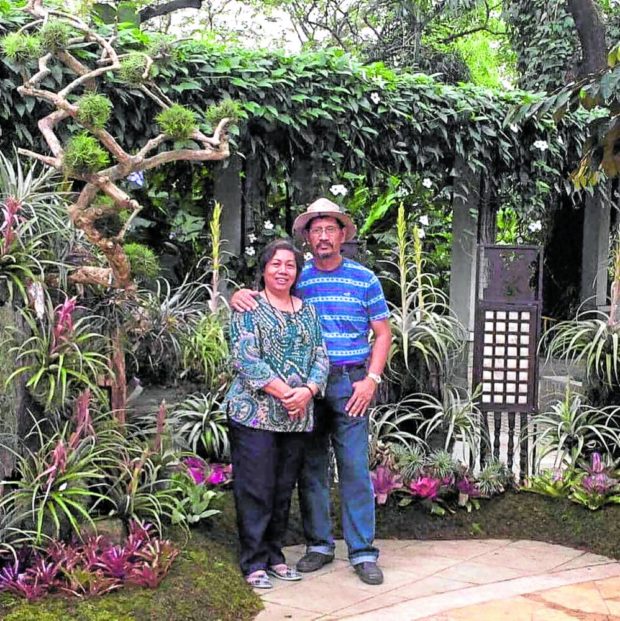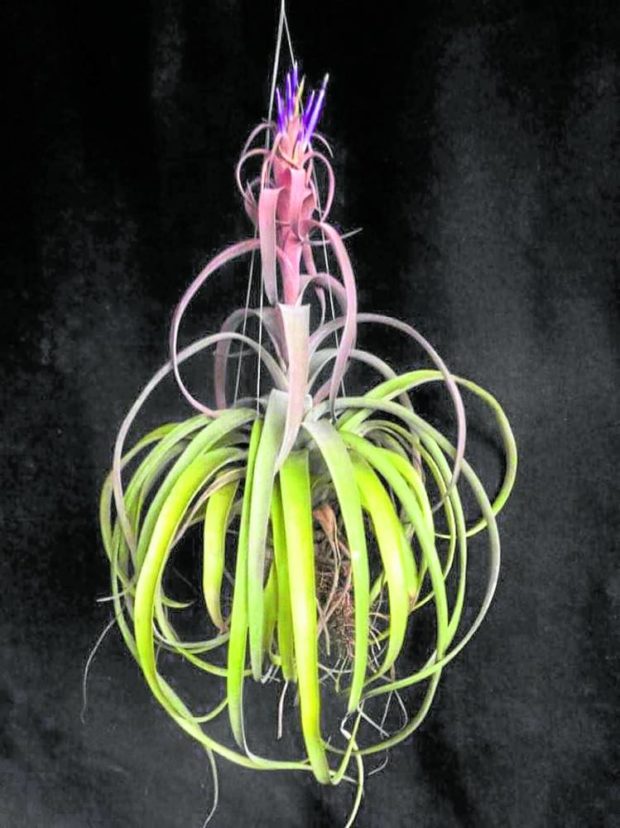Money grows on ‘tillies’!

TILLY HAVEN The Dofitas turned their passion into business
BACOLOD CITY, Negros Occidental—A botanical garden in a local village has made a name for itself in the horticulture industry here and abroad.
Flora Botanica by Tilly Culture is a wonder to behold due to its vast collection of air plants commonly known as tillandsias.
Owned by couple Rene and Doreen Dofitas, the garden occupies a 760 square-meter lot next to their home in Greensville 2 Subdivision in Barangay Villamonte, a few minutes away from the New Government Center.
The business started as Bloomington in 1995 but was rebranded to Flora Botanica by Tilly Culture. They then started displaying plants in public spaces like Panaad Park and malls in Bacolod City.
While Flora Botanica boasts of a wide assortment of ornamental plants like any other plant shop, what sets them apart is their collection of tillandsias that they breed and export.
Tillandsia is a kind of bromeliad, a family of plants characterized by the spiral structure of their stiff silvery-green leaves.
Unlike most plants, tillandsias do not require soil or any medium to grow. They mainly use their roots to hang on to other plants or structures for support.
They can be mounted on a variety of materials like driftwood, rocks, metal or glass.
Their leaves have scale-like structures that enable them to trap moisture and dust, from which they draw nutrients to grow.
Tillandsias are prized for their size and form. Some grow their leaves into rosettes while others hang their leaves loose or twist them like wires.
There are those that almost look like sculptures with the way their bracts are arranged.
Some are as small as a few centimeters while others can grow to more than a meter in both diameter and height.
They also come in a variety of colors: green, red, pink and violet.

Flora Botanica by Tilly Culture boasts of a vast collection of tillandsia and tillandsia hybrids that literally fill the property to the brim.
Something new
Rene, who handles the hybridization process, says his passion for tillandsias started when he first saw the plants when he visited Europe as a football coach decades ago.
Already an avid plant hobbyist, these plants captivated Rene due to their uniqueness and form.
Every time he travels since then, he brings home new varieties. He and his wife also started buying from local sellers who sourced plants abroad.
Rene started breeding tillandsia in 1997 and has been cross- breeding every day since then.
Doreen—also a plant hobbyist who is in charge mainly of marketing—says they decided to breed tillandsias when these became too expensive and unaffordable.
“Rene thought, why not go into breeding? We have some species already and hybrids are already coming out from other nurseries [abroad], and they are very expensive,” she says. Rene believed that if others could do it, he could too. Rene saw so much untapped potential in the local horticulture scene. He lamented how the country has lagged in producing “something new” in the horticulture industry despite its rich and diverse flora.
He then made it his mission to create something new that would bear the Filipino mark. Knowing that there was no chance to compete in farming other ornamental plants like aroids and orchids, which are already widely and rapidly bred in other countries, he found his niche with tillandsias.
He says tillandsias have evened out the playing field. It requires more than a decade for such plants to reach maturity; no technology yet exists to hasten this process.
The Philippines’ tropical climate is also ideal for growing and breeding the plant. Here, it takes about five to six years to grow seeds into seedlings and 12 years to produce mature, flowering and stable hybrids. It takes twice longer for US breeders to do so, Rene says.

BREEDERS Doreen and Rene Dofitas with their world-renowned tillandsia hybrids —Photos courtesy of Doreen Dofitas
Prized collection
To date, they have produced more than 500 tillandsia hybrids, says Doreen, 15 of which are officially registered with the Bromeliad Cultivar Registry under the Bromeliads Society International.
They named some of these hybrids after themselves and their children. Their first and most sought-after hybrid, is Tillandsia Mali Dofitas, named after their eldest daughter. This hybrid is characterized as bulbous-based and spidery, with an upright rosette of a few thick channeled and reddish green leaves. It can grow up to 57 centimeters tall.
A medium-sized Mali Dofitas was once sold abroad for as much as $300 (P17,700 using an exchange rate of P59 to a dollar).
Doreen says Mali Dofitas is being used by breeders around the world as a parent plant to create new hybrids.
“Knowing this made us happy. [This means that] they have so much respect for the plant, and they see its potential that’s why they’re using it,” she says.
Among their best-selling hybrids are Tillandsia Rene Dofitas, Tillandsia Rene’s Passion, Tillandsia Rene’s The Other One, Tillandsia DDD (Doreen De Asis Dofitas) and Tillandsia Silver Torch.
A Silver Torch (around 35 inches in diameter) that had won in a garden show in Manila fetched P13,000 just before the pandemic.
Through garden shows, fairs and conventions, their hybrids have gained national and international following.
They may be the first tillandsia breeder to release hybrids en masse in the local market, Doreen reckons. Tillandsia and bromeliad aficionados have come to know them, especially foreign hobbyists who appreciate the distinct qualities of tillandsias. Hobbyists seek them out either to buy their hybrids or gain insight from their practice, Doreen says.

NO NEED FOR SOIL Tillandsia Macel’s Choice, one of their homegrown plant babies
Pandemic boom
The couple has proven that breeding ornamental plants can be a lucrative business.
Flora Botanica started exporting air plants in 2005. They were among the first to produce tillandsia hybrids in Asia; back then, breeders from Thailand, Vietnam, Indonesia and Singapore sought them out to buy hybrids. Now, their offshore market has expanded to Taiwan, Japan, China and the United States.
Doreen says they were earning as much as P50,000 to P60,000 a month from selling hybrids before the pandemic. This doubled during the pandemic, thanks to their live selling sessions that drew people who have turned to gardening during the lockdowns.
Participating in a 10-day local garden show could generate P80,000 for them during the entire run.
At one time, they earned P300,000 in a single day from selling a hybrid during an international garden show.
While there were times when the garden did not generate as much income, Doreen says they have never felt that their investment is going to waste.
Investing in gardening and horticulture has really paid off, she says.
“We may not have enough money in the bank, but this garden is our bank,” she says.
Income from the garden has enabled them to live a comfortable life. It has allowed them to send all of their four children to college. They have been able to travel abroad. And when illness had stricken their family—both Rene and daughter Mali are cancer survivors—it helped them with the medical expenses.
“During the pandemic, if we needed money, the garden helped us pull through,” she added.
Rene, 68, and Doreen, 55, once aspired to mass produce all of their hybrids, but their age and the lack of resources make this difficult.
“We are not that young anymore. If we are going to manage a very big farm, we will need people. We need space, which is not viable for us. The amount of work that it requires will not be for us anymore. So, we have decided to let others do the mass production while we produce the new ones,” says Doreen.
More than 25 years has passed since they turned their passion into a business, but Rene and Doreen have no plans of putting down their gloves and trowels anytime soon.
